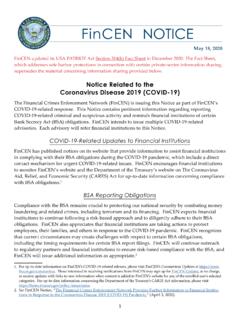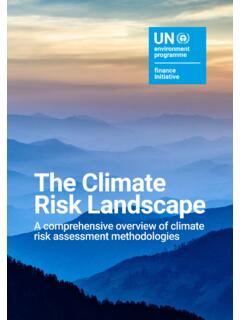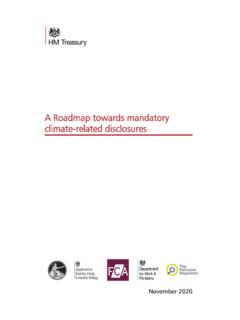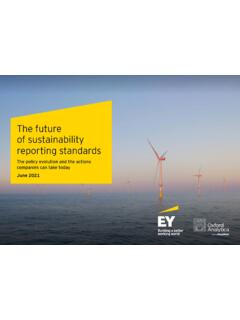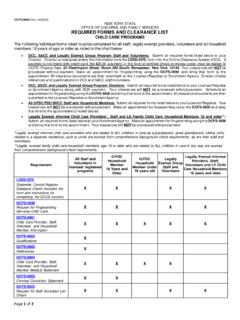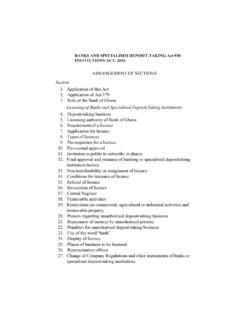Transcription of Platform on Sustainable Finance: Considerations on ...
1 1 Platform Considerations on voluntary information as part of Taxonomy-eligibility reporting APPENDIX 1 2 Appendix 1 Platform Considerations on voluntary information as part of Taxonomy-eligibility reporting Table of Contents 3 Preface from the Platform for Sustainable 3 The value of voluntary Information .. 5 Why should I voluntarily report? .. 5 How can I provide voluntary information? .. 6 Is it possible to estimate turnover as Taxonomy-eligible in a voluntary report? .. 6 Is it possible for financial undertakings to estimate Capital Expenditures as Taxonomy-eligible in a voluntary report? .. 7 When and how can Taxonomy-eligible debt use of proceeds be included in a voluntary report? .. 7 Can I use the reporting Annexes for my voluntary disclosures ? .. 9 How can I use Annex II for my eligibility reporting requirement?
2 10 Option One where alignment is not yet known .. 10 Option Two where a company has completed or partially completed their alignment assessment .. 10 Can a company establish materiality thresholds while calculating Taxonomy-eligible Turnover, CapEx and OpEx?.. 11 General Guidance on use of Annexes I and II for eligibility reporting requirements .. 11 How can I use Annex IV for my eligibility reporting requirement? .. 12 How can I use Annex VI for my eligibility reporting requirement? .. 14 Transparency and learning curve .. 16 3 Disclaimer The Considerations below are compiled under the aegis of the Platform on Sustainable Finance, and cannot be construed as official guidance by the European Commission or by the European Supervisory Authorities. This document is provided online to provide supplementary information in order to help users of the EU Taxonomy with the disclosures required under Article 8 of the Taxonomy Regulation.
3 The following voluntary guidance supplements the Commission s FAQs document, which provides first hand non-binding implementation guidance on the content of the mandatory disclosures under the Article 8 disclosures Delegated Act of EU Taxonomy Regulation. voluntary reporting should be prepared on a basis that does not contradict or misrepresent the mandatory information pursuant to the disclosures Delegated Act and it should not be given more prominence than the mandatory disclosures . Where an undertaking includes voluntary reporting, this should be accompanied with a clear explanation on how it differs from mandatory reporting and details on the methodology used. Preface from the Platform for Sustainable Finance The Taxonomy Regulation (Regulation (EU) 2020/852 of 18 June 2020)1 is an essential component of the European Commission s action plan to reorient capital flows towards a more environmentally Sustainable economy and it represents an important step in the EU's objectives to deliver on its 2030 climate goals and achieve climate neutrality by 2050.
4 The EU Taxonomy is a transparency tool, which provides a unified classification system of activities that can be considered environmentally Sustainable . The EU Taxonomy sets out a disclosure obligation (the Article 8 disclosures Delegated Act)2 for entities which are already within scope of the EU Non-Financial Reporting Directive (NFRD).3 These In-scope Entities are either large undertakings which are public-interest entities with more than 500 employees or public-interest entities which are parent undertakings of a large group with more than 500 employees. The Article 8 disclosures Delegated Act is separate from the disclosure obligations set out under Articles 5, 6 and 7 of the Taxonomy Regulation, which is applicable to financial products (as defined under the Sustainable Finance Disclosure Regulation4) and lay out an additional set of non-financial disclosures .
5 The Article 8 disclosures Delegated Act requires in-scope entities to include in their non-financial statements or consolidated non-financial statements information on how and to what extent their activities are associated with Taxonomy-aligned economic activities. The Article 8 disclosures Delegated Act applies to both financial undertakings and non-financial undertakings that qualify as in-scope entities. A financial undertaking can be an asset manager, a credit institution, an investment firm, an insurance undertaking, or a reinsurance undertaking. 1 Regulation (EU) 2020/852 of 18 June 2020: EUR-Lex - 32020R0852 - EN - EUR-Lex ( ) 2 3 Directive 2013/34/EU of 22 October 2014: EUR-Lex - 32014L0095 - EN - EUR-Lex ( ) 4 Regulation (EU) 2019/2088 of the European Parliament and of the Council of 27 November 2019 on sustainability-related disclosures in the financial services sector: EUR-Lex - 32019R2088 - EN - EUR-Lex ( ) 4 In-scope entities will have different key performance indicators, or KPIs5, and forms of disclosure depending on whether they are a financial or non-financial undertaking and on the type of financial undertaking.
6 This Appendix supports non-financial and financial entities wishing to make voluntary disclosures related to the Article 8 disclosures Delegated Act for in-scope entities only. - Non-financial undertakings should disclose the proportion of their turnover derived from products or services associated with Taxonomy-aligned economic activities and the proportion of their capital expenditure and operating expenditure related to assets or processes associated with Taxonomy-aligned economic activities. - Financial undertakings should disclose KPIs which relate to the proportion of Taxonomy-aligned economic activities in their financial activities, such as lending, investment and insurance. These are referred to as the Green Asset Ratio (GAR) for credit institutions or banks, and Green Investment Ratio (GIR) for asset managers.
7 The Article 8 disclosures Delegated Act specifies the content and presentation of information as well as the methodology to calculate the relevant KPIs. These requirements are set out in annexes to the Delegated Act for each type of In-Scope In addition, there are some overarching disclosure rules which apply to all in-scope entities: disclosures shall cover the annual reporting period from the previous calendar year of the date of disclosure, as covered in the Commission s FAQs document. disclosures shall use the same currency as in the financial statements of the in-scope entity. Disclosure rules applicable to all financial undertakings which are in-scope entities include: exposures to central governments, central banks and supranational issuers are excluded from both the numerator and denominator of the KPIs. exposures to undertakings which are not themselves in-scope entities as well as derivatives are excluded from the numerator of the KPIs.
8 Financial undertakings should use the most recently available data and KPIs of their counterparties, investee companies and exposures to calculate their own KPIs. The Article 8 disclosures Delegated Act will become effective on a phased basis, with the first phase relating to the Taxonomy-eligibility of economic activities and the second phase relating to the Taxonomy-alignment of economic activities ( , disclosure of the KPIs). 5 Three KPIs for Taxonomy Reporting purposes are the Turnover, Capital and Operating Expenditure 6 Implementing and Delegated Acts 5 The value of voluntary Information During the first few years of Taxonomy reporting, financial institutions may find it difficult to get all the required information from companies and other economic actors to calculate eligibility.
9 The Taxonomy complements the scope of reporting within the NFRD. Companies subject to NFRD reporting requirements will provide the necessary data needed for financial undertakings to comply with their own obligations under the Taxonomy Regulation. The Platform strongly recommends that issuers and financial market participants swiftly adapt their internal data collection and processing systems to the architecture of the Taxonomy Regulation to be able to address most efficiently and effectively the disclosure requirements under Article 8 as well as to improve any voluntary reporting and to ensure that the Taxonomy regime can also contribute to the timely and effective risk management of sustainability related risks and impacts. The Platform acknowledges that financial institutions may wish to report the eligibility of their full investment profile or balance sheet.
10 However, in the absence of information, this would require the use of estimates for the non-NFRD ( , non-disclosing) universe of counterparties or investee companies for example. In some cases, notably in the first reporting year, financial undertakings may also wish to estimate for their NFRD underlying exposures, whilst awaiting their first Taxonomy disclosures . Estimates and proxies are not allowed to be used for the mandatory reporting under Article 8 of the Taxonomy Regulation. Yet, entities may disclose additional information on a voluntary basis, separately from the Article 8 disclosures and clearly identified as estimates or proxies. To do this, the Platform has developed a set of criteria to frame the methodologies and promote consistency for the use of estimates and proxies on eligibility, and developed principles-based, illustrative guidance for such voluntary reporting.










